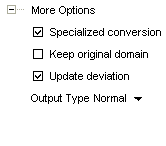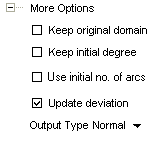| Specialized conversion |
Enables you to control the type of the resulting NURBS surfaces.
- When this box is selected surfaces are converted to specialized NURBS. Specialized NURBS are much more accurate and have a lower number of control points. See "Specialized conversion" for details.
- When the box is cleared, surfaces are converted to non-specialized NURBS.
|
| Keep initial degree |
This check box is active only when the Continuity order is set to Maximum.
- When selected, the resulting surface will have the same degree as the original one.
- When not selected, the resulting surface degree may differ.
|
| Keep original domain |
Enables you to control the domain of the resulting entity.
- When this check box is selected, the domain of the resulting entity will have the same size as the one of the original entity.
- When not selected, the domain of the resulting entity may differ from the original (and be smaller).
|
| Use initial no. of arcs |
- When the box is checked, you can perform the conversion based on the number of arcs of the entity to convert: this number is added to the specified maximum number of arcs, so as to have a more coherent result for each surface.
- When the box is cleared, the initial number of arcs of the entity to convert is not taken into account.
|
| Update deviation |
Enables you to control the precision of the resulting surfaces.
- When this check box is not selected, the resulting entity will keep its own local precision value.
- When selected, the achieved precision will be assigned to the local precision of the resulting entity.
|
| Output type |
Enables you to select the output type for the resulting surfaces.
| Standard |
To convert the selected surfaces without splitting them. |
| Single-patch surfaces |
To convert the selected surfaces by splitting them into as many single-patch surfaces as required. |
| Bezier surfaces |
To convert the selected surfaces by splitting them into as many Bezier surfaces as required (that is, single-patch surfaces for which the U and V parameters vary in the range [0,1]). |
|





